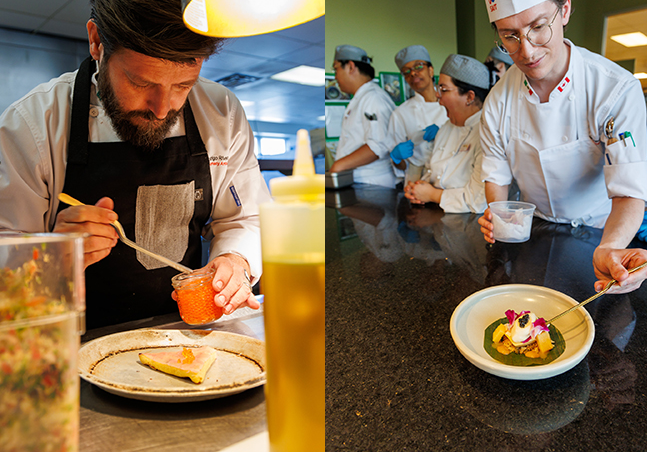Culinary diplomacy, at its core, is about connection. It is about learning and sharing experiences as a way to foster relationships and understanding between countries, cultures and individuals. When Chef Rosalyn Ediger began her Cadmus Chair tenure in January 2020, her goal was to develop a specialized course in culinary diplomacy and food culture at SAIT's School of Hospitality and Tourism.
"The big picture is to have a training program for culinary diplomats at SAIT," says Ediger. "Students can extend their learning to take courses that have more to do with culinary diplomacy, such as international affairs, food history and everything from geography to etiquette."
Cadmus Teaching Chair
The Cadmus Trades Teaching Chair demonstrates SAIT's commitment to quality instruction by recognizing and fostering faculty excellence in trades training it celebrates the very best of SAIT's trades instructors.
Chef Rosalyn has shared her passion for diplomacy with her colleagues, which drove Chef Romina Campuzano to champion an international culinary exchange with the support of a hospitality and tourism committee made up of faculty and staff.
"I was new to culinary diplomacy when I met Chef Rosalyn and she was so excited about it. She introduced it to me as a relationship between two countries through food and through culture," says Chef Romina. "Food can bring us together in a very comforting way and we want to show that to our students while always respecting the culture of each country and their traditions."
Recently, SAIT hosted two notable chefs from Monterrey, Mexico to Calgary on our second culinary diplomacy exchange. Chef Irving Quiroz, an accomplished baker and chef, instructor and author, and Chef Rodrigo Rivera-Rio, a newly awarded MICHELIN star chef who specializes in gastronomy, joined SAIT's hospitality and tourism team for a week of knowledge sharing.
Our guests were welcomed to campus with a traditional smudge and blessing at Natosopoyiis to acknowledge the Treaty 7 land on which we reside, work and play, and to set the tone for cultural learning and community. Elder Betty Crazyboy offered a history of the land, along with the impacts of colonization and the Indian Residential School System, and Indigenous dancers performed accompanied by traditional drummers.
Chefs Irving and Rodrigo toured SAIT's hospitality and tourism facilities, led and participated in cooking, baking and beverage education demonstrations with our students and instructors. They were shown around the city along with a group of students to explore street art murals found in Calgary's public spaces and view the newly redeveloped BMO Centre. They spent time at a farmers' market sampling local goods, and a trip to Alberta isn't complete without a day in Banff.

"I've been in a lot of places and kitchens and schools, and SAIT is the best I've been to. From the programs and equipment to the passion you see from the chef instructors and students. I think you have an awesome school," says Chef Rodrigo. "I always tell people that culinary studies are 50% school and 50% practice in the real world. Your students get both and when they graduate, they'll be ready for the real world."
A sense of community
Reflecting on the week, a theme of community tied the experience together. Whether it was students in a kitchen working together to achieve success as a class or the sense of pride and delight they exhibited while exploring our city, or chefs discussing their holistic approach to running a restaurant or school.
"Chefs come from different parts of the world, at different ages and from different cultures. That could separate people, but what I see here at SAIT is everybody is working together. Everybody has the same respect for each instructor, and the most important thing is they really work as a team, as a community," says Rivera-Rio.
Chef Irving who taught both Rivera-Rio and Campuzano at the Culinary Institute of Mexico was impressed by the quality weaved through our students' education and experience at SAIT.
"The quality here is something I hope to take back to my school. I have studied in many schools from Mexico, Spain, the U.S. and France, and I realize that SAIT has such high quality in everything you do. From your ingredients to your instructors, I can't imagine any school that does it better," says Quiroz.
Hospitality and Tourism students who participated in the opportunities for learning throughout the exchange were given unique insights into Mexico's culinary and hospitality landscape. By exploring different ingredients and flavours and introducing to new techniques into their skills, students will carry this experience forward into their careers.
"I hope for the students to see the work we've put into becoming chefs and we can inspire them. Teaching Mexican bread and sharing my baking with the students during the baking demonstration was the best," says Quiroz.
The week's events culminated with a contemporary Mexican dining experience Que Rica Comida, which translates to that delicious food. A three-course dinner featuring seasonal and locally sourced ingredients was prepared by Chefs Irving and Rodrigo and SAIT culinary students. Tourism Calgary performed a White Hat Ceremony and traditional Mexican folklore dancers entertained event guests at the Highwood Kitchen + Bar.

"We will take this experience through the rest of our lives. Not just the techniques and the culinary side, but the human side. How these chefs really know their guests and make them feel at home they reminded us how important it is to be humble and kind," says Campuzano. "But the most important moment for me was when I saw the Mexican flag on campus next to the Canadian flag. Showing respect to my country and my culture was really special."













